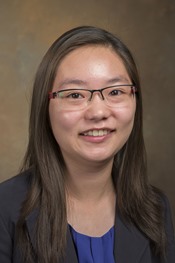Program Information
Use of 3D Gels for Determining MR and Radiation Isocenters in MR-Guided Radiation Therapy
H Lee1*, G Bosco2 , M Kadbi3 , G Ibbott1 , (1) UT MD Anderson Cancer Center, Houston, TX, (2) Elekta, Atlanta, GA, (3) Philips Healthcare, Cleveland, OH
Presentations
SU-I-GPD-J-68 (Sunday, July 30, 2017) 3:00 PM - 6:00 PM Room: Exhibit Hall
Purpose: Without the guidance of lasers or light field in a 1.5T MRI and 7MV linear accelerator (MR-Linac), the conventional methodology of acquiring a star shot pattern to identify the radiation isocenter is no longer sufficient. In this study, we present an alternative technique with MR-visible 3D gels to identify corrections needed to register the MR and radiation isocenters.
Methods: Two types of tissue-equivalent gels in cylindrical containers were used: a novel reusable radiochromic gel and a MAGAT polymer gel. The gels were irradiated with 1x1 cm² fields at gantry angles 16°, 45°, 75°, 120°, 150°, 210°, 240°, 285°, 315°, and 345°. The gels were MR imaged post-irradiation with T1-weighted sequences for the radiochromic gel and T2-weighted sequences for the polymer gel. MR images were acquired at the MRI magnet isocenter without any offset in the slice location. Since registration corrections had not yet been implemented at the time of this study, the MR coordinates (0,0,0) did not necessarily correspond to the radiation isocenter location. Regions with radiation induced MR changes were contoured in the Monaco TPS, and the center of the contoured region was compared to Monaco TPS’s radiation isocenter location.
Results: For the radiochromic gel, the location of the MR isocenter was found to be up to 0.7mm
Conclusion: This study has proven the feasibility of using 3D gels as tools for identifying the location of the radiation isocenter and its relation to the MR isocenter location in an MR-guided radiation therapy system. Similar to the existing phantom techniques using MR markers, the resolution of this methodology is limited by MR image quality.
Funding Support, Disclosures, and Conflict of Interest: This material is based upon work supported by the National Science Foundation Graduate Research Fellowship Program under Grant No. LH-102SPS.
Contact Email:
